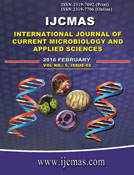


 National Academy of Agricultural Sciences (NAAS)
National Academy of Agricultural Sciences (NAAS)

|
PRINT ISSN : 2319-7692
Online ISSN : 2319-7706 Issues : 12 per year Publisher : Excellent Publishers Email : editorijcmas@gmail.com / submit@ijcmas.com Editor-in-chief: Dr.M.Prakash Index Copernicus ICV 2018: 95.39 NAAS RATING 2020: 5.38 |
The present investigation reveals that the impact of human activities on Tamaranga (beel) wetland a case study from Bongaigaon district, Assam, India. The wetland is situated 260 19’08’’N latitude and 90034’19’’E longitude in Bongaigaon district of Assam, covering an area of 627 ha. It is one of the inland of wetlands such as disturbances in physical, chemical and biological processes in an ecosystem and regulating climatic condition. The main human activities are use of wetland area for different natural wetland. The average annual rainfall is 3000mm. with maximum and minimum temperature of 360C and 70C respectively. The present study is focusing on the impact of human activities on functioning purposes like construction of houses, roads, agricultural land and overfishing etc. the area of wetland is going to decrease day by day due to human encroachment. It disturbing landscape functions cycling of carbon, water and nutrients, water purification, regulation of flow, support for animal migration etc. and increasing the risk of extreme events like, floods, droughts etc.
 |
 |
 |
 |
 |